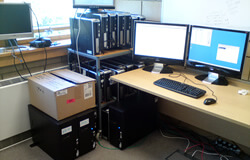Computers
Watch the pixels dance!
I've been interested in computers since I first got my own one in my early teens. I took it apart and quickly put it back together again before my parents noticed. Since then I have worked on many computers with different operating systems and for different purposes. I've repaired, upgraded, maintained and built computers for friends and family. Since late 2007 I have been part of the Linux From Scratch community where I learnt a lot about how all the software packages come together to make a Linux distribution.
Jupiter HPC (2011)

The Jupiter High Performance Computing cluster is a collection of computers working together to resolve a problem in a shorter space of time than any one computer could do it in. This allows for more tasks, or more complex tasks, to be completed within the same timeframe. It was built to run ANSYS physics simulations for Anglia Ruskin University’s Medical Research and Engineering departments. The cluster created so much heat the office window had to be open at all times.
An older cluster called Nectar which consisted of just the NEC computers was used for my undergraduate dissertation. It ran Windows HPC Server 2008 and Rocks Linux and drew 650w idle and 1150w under load. The name Nectar is a combination of NEC and the UNIX program “tar”. The nodes were four years old before the cluster was built and a number of them died during my dissertation and afterwards when building Jupiter.
Specs
Viglen Node x 3
- CPU: 2 x Intel Xeon E5410 2.33Ghz
- RAM: 4 x 1GB DDR2 ECC
- GFX: ATi FireGL V7600 256MB GDDR3
- HDD: Western Digital 160GB SATA
NEC Node x 14
- CPU: AMD Athlon64 3400+ 2.2Ghz
- RAM: 1GB DDR1
- GFX: ATi Xpress M300 16MB Shared
- HDD: 160GB SATA
Note: There where 18 to begin with.
Misc
- Windows HPC Server 2008 R2
- Cisco 2900 100Mb/s x 24 ports
- 30 Computing Cores
- 30GB Computing RAM
- Viglen head node had additional 1TB drive
Home Server

I built a linux server in late 2007 using a old Pentium 3 that used to be our family computer. The heatsink was replaced with a quieter one and a large hard drive and network card were installed. I built it to learn how to install, configure and manage server software. It ran Debian at first but was then replaced with a Linux From Scratch build where I had to compile and configure all the software from source. It has been upgraded a number of times over the years, either to increase the hard drive storage or due to hardware failure.
The server runs 24/7 without a UPS because powercuts are rare where I live. When they do occur something often goes wrong due to the old hardware or because the server hasn't been turned off in over 100 days. The main purpose is as a large file system with a lot of hard disks. To reduce power consummation, heat and noise the main hard drive has been replaced with a SSD and the hard drives spin down when inactive. The case was chosen because of the number of drives it can old, the possibility of expanding it to add more and the soundproofing built into it.
Specs
Hardware
- CPU: Intel Core 2 Q6600 2.4Ghz
- RAM: 4GB DDR2
- GFX: Matrox G200
- PSU: Corsair CX600
- Case: Nanoxia Deep Silence 1
- Cooler: SilverStone AR01
Storage
- SSD: Patriot Blaze 60GB
- HDD: Samsung Spinpoint SP2014N 200GB IDE
- HDD: 2 x Samsung Spinpoint 500GB SATA2 RAID 1
- HDD: 4 x Seagate 7200.12 2TB SATA3 RAID 6
Software
- Distro: Ubuntu
- Version: 14.04 LTS
- Kernel: Linux 3.16.0-34
Misc
- Idle: 88W
- Boot: 260W
- Weight: 19.4 KG
Daily Computers

Here are the computers I use almost everyday. The mac is my everyday computer and the PC is for gaming and videos. I have a very powerful computer at work so that I can run multiple virtual machines at once and not have to worry about it slowing down or having to close programs to free up RAM. The laptop and mac are old computers that were given to me and I fixed and my desktop was a cheap second hand computer from a friend that I ended up replacing everything over time apart from the case. The workstation was built by me for work and is the only new computer I use, being over powered means it runs so fast.
Workstation
- CPU: Intel i7 3.79Ghz
- RAM: 2 x 8GB DDR3
- GFX: Intel HD 4500
- SSD: Samsung 256GB
- HDD: Samsung 2TB
- OS: Mac OS X 10.9.2
2006 Mac Mini
- CPU: Intel Core Duo 1.83Ghz
- RAM: 2 x 1GB DDR2
- GFX: Intel GMA 950
- HDD: Fujitsu 80GB
- OS: Mac OS X 10.6.8
Desktop
- CPU: Intel Core 2 Quad Q6600 @ 2.75Ghz
- RAM: 2 x 2GB DDR3
- GFX: Nvidia 670 GTX 2GB
- SSD: Samsung 128GB
- HDD: Seagate 2TB
- OS: MS Windows 7 Pro 64bit
Laptop
- CPU: Intel Core M-5Y10c
- RAM: 2 x 4GB DDR3
- GFX: Intel HD 5300
- SSD: 256GB
- OS: Windows 10 / Fedroa 25